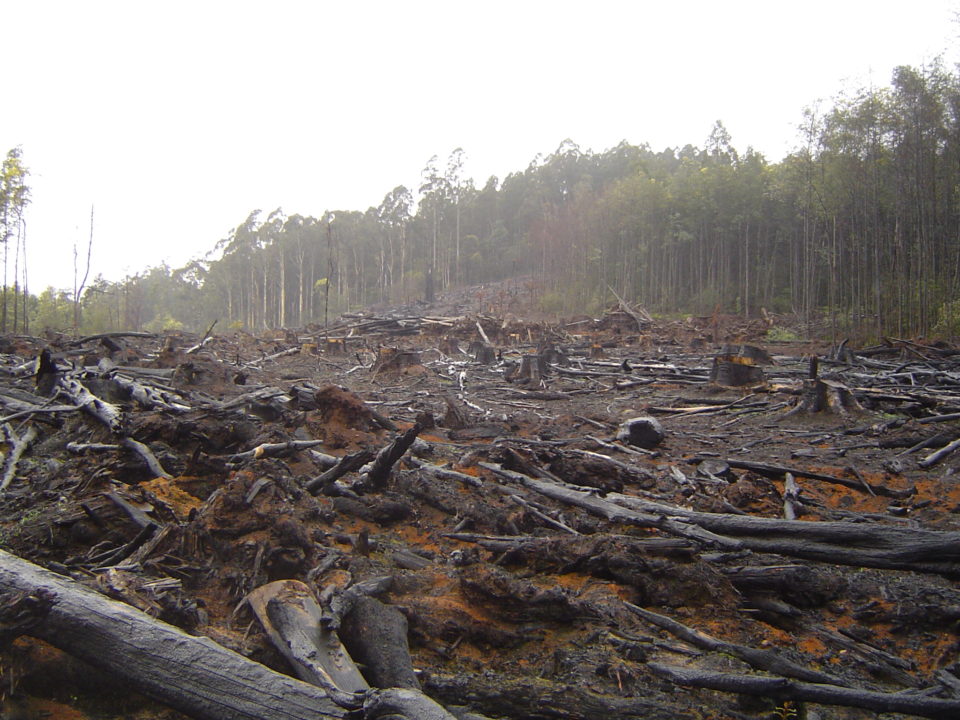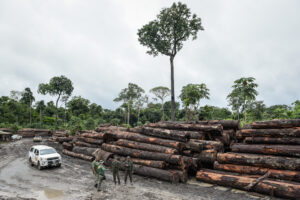‘Not a Single Global Indicator Is on Track’ to Reverse Deforestation by 2030: Analysis
There is no way to limit global warming to 1.5°C unless the world stops felling trees to make space for cattle ranching, monocropping, and other harmful practices, experts warn. Photo: crustmania on Flickr / CC BY 2.0
Photo: crustmania on Flickr / CC BY 2.0
Although halting and reversing deforestation by 2030 is key to averting the worst consequences of the climate and biodiversity crises, the world is off course to achieve these critical targets and urgent international action is needed, an analysis warned Monday.
During the United Nations’ COP26 climate summit last November, 145 nations signed the Glasgow Leaders’ Declaration “to halt and reverse forest loss and land degradation” by the end of the decade.
One year later, “not a single global indicator is on track to meet these 2030 goals of stopping forest loss and degradation and restoring 350 million hectares of forest landscape,” according to the annual Forest Declaration Assessment.
“To be on course to halt deforestation completely by 2030, a 10% annual reduction is needed,” the report notes. “However, deforestation rates around the world declined only modestly, in 2021, by 6.3% compared to the 2018-20 baseline. In the humid tropics, loss of irreplaceable primary forest decreased by only 3.1%.”
“Tropical Asia is the only region currently on track to halt deforestation by 2030,” thanks to the “exceptional progress” made by Indonesia and Malaysia, which reduced clear-cutting by 25% in 2021, states the report. “While deforestation rates in tropical Latin America and Africa decreased in 2021 relative to the 2018-20 baseline, those reductions are still insufficient to meet the 2030 goal.”
Globally, 26,000 square miles of forest—an area roughly equivalent to the Republic of Ireland—were destroyed in 2021. This deforestation decimated biodiverse ecosystems and released 3.8 billion tons of greenhouse gas emissions into the atmosphere, about as much as the European Union.
“Funding for forests will need to increase by up to 200 times to meet 2030 goals,”
Experts have long warned that it will be virtually impossible to maintain a habitable planet unless the world stops felling trees to make space for cattle ranching, monocropping, and other harmful practices.
Even though “notable progress in afforestation and reforestation efforts over the last two decades have resulted in new forest new forest areas the size of Peru, with net gains of forest cover in 36 countries… overall losses exceeded gains over the same period, resulting in a net loss of 100 million hectares globally,” according to the report.
Furthermore, “forest cover gains, through reforestation and afforestation activities, do not compensate for forest loss in terms of carbon storage, biodiversity, or ecosystem services,” the report explains. “Therefore, highest priority efforts should be directed towards safeguarding primary forests from losses in the first place.”
Fran Price, global forest practice lead at World Wildlife Fund, one the groups involved in the report, called the Forest Declaration Assessment “another warning signal that efforts to halt deforestation are not enough and we’re not on track to achieve our 2030 goals.”
“There is no pathway to meeting the 1.5°C target set out in the Paris agreement or reversing biodiversity loss without halting deforestation and conversion,” said Price. “It’s time for bold leadership and for daring solutions to reverse this alarming trend.”
Key findings from the report’s section on sustainable production and development include:
- We are not on track to achieve the private sector goal to eliminate deforestation from agricultural supply chains by 2025, and corporate action in the extractives sector also remains limited;
- REDD+ (reducing emissions from deforestation and forest degradation) programs have not yet yielded a reduction in deforestation, and only a handful of countries have received payments for forest emission reductions;
- In most countries, governments have yet to make the bold sectoral reforms needed to protect forests;
- There are very few examples of government-led poverty reduction programs that both prioritize forest impacts and are implemented at scale; and
- 200 land and environmental defenders were killed in 2021, and the mining and extractives sector is consistently ranked as one of the deadliest for defenders.
“To ensure that 2025 and 2030 do not pass as 2020 did—with limited progress toward global forest goals—governments, companies, and civil society must collaborate to accelerate forest action,” states the report.
The authors recommend that governments adopt and enforce much stronger regulations to prevent deforestation and human rights abuses while also calling on corporations to “increase the scope and stringency” of efforts to remove deforestation from their supply chains and reduce the negative forest impacts of extraction.
According to the section on forest finance, “It will cost up to $460 billion per year to protect, restore, and enhance forests on a global scale. Currently, domestic and international mitigation finance for forests averages $2.3 billion per year—less than 1% of the necessary total.”
“Funding for forests will need to increase by up to 200 times to meet 2030 goals,” notes the report. “Finance pledges made in 2021 demonstrate a substantial increase in ambition to meet 2030 forest goals. If they are fully delivered, they would quadruple annual finance for forests from 2021-25 to $9.5 billion. Yet, funding would still need to increase by up to 50 times to meet investment needs.”
It’s time for bold leadership and for daring solutions to reverse this alarming trend.”
“IPs [Indigenous peoples] and LCs [local communities], who are the most effective stewards and guardians of their forest territories, receive far less funding than their estimated finance needs for securing tenure rights and preserving forest ecosystems,” the report finds. “Only 1.4% of total public climate finance in 2019-20 was targeted toward IPs and LC’s needs, and only 3% of the financial need for transformational tenure reform is being met annually.”
Moreover, “most financial institutions still fail to have any deforestation safeguards for their investments,” the assessment points out. “Almost two-thirds of the 150 major financial players most exposed to deforestation do not yet have a single deforestation policy covering their forest-risk investments, leaving $2.6 trillion in investments in high deforestation-risk commodities without appropriate safeguards.”
Spending $460 billion per year on global forest protection and restoration—substantially less than the United States’ annual military budget—”is an investment that we cannot afford not to make,” the authors emphasize. “Achieving the 2030 forest goals is essential for ensuring a livable world in line with the Paris agreement.”
To that end, the report implores “governments, companies, and financial institutions to utilize all tools at hand to substantially increase their investments in forests, while also shifting finance away from harmful activities.”
A final section on forest governance argues that more robust policy and legal frameworks are required to curb deforestation, land degradation, and human rights violations.
Tools such as “moratoria, strengthened enforcement capacity, smart conservation policies, and improved transparency and accountability are effective in protecting forests—as evidenced by remarkable reductions in deforestation in various periods since 2004 when these tools have been employed in Indonesia, Ghana, Côte d’Ivoire, Gabon, Guyana, and Brazil,” the report notes.
However, the report points out, “some of these achievements have been reversed—notably in Brazil—or are at risk of being reversed as countries phase out or roll back policy gains through recent or proposed amendments.”
Since assuming office in 2019, far-right Brazilian President Jair Bolsonaro has accelerated the destruction of the Amazon rainforest, endangering the future of human beings and other species. Luiz Inácio Lula da Silva, his popular leftist opponent who was president from 2003 to 2010 when Brazil made progress toward halting deforestation, currently has a six percentage point lead in the polls ahead of Sunday’s runoff election.
“Nothing less than a radical transformation of development pathways, finance flows, and governance effectiveness and enforcement will be required to shift the world’s forest trajectory to attain the 2030 goals.”
“The Brazilian elections are not just about the future of Brazil, the result will have an impact on all of humanity,” Paul Morozzo, senior food and forests campaigner at Greenpeace U.K., said earlier this month. “If we lose the Amazon, we lose the fight against the climate crisis.”
While the report is focused on forest ecosystems, the authors stress that “globally, terrestrial and coastal ecosystems including savannas, grasslands, scrublands, and wetlands are all under threat of conversion and degradation.”
“Countering this threat for all ecosystems is essential to meeting global climate and biodiversity goals” and “will require a drastic reduction in the conversion and degradation of all natural ecosystems and a very large increase in restoration and reforestation activities, which must be pursued through equitable and inclusive measures,” they continue.
The report adds that “nothing less than a radical transformation of development pathways, finance flows, and governance effectiveness and enforcement will be required to shift the world’s forest trajectory to attain the 2030 goals.”
Your support matters…Independent journalism is under threat and overshadowed by heavily funded mainstream media.
You can help level the playing field. Become a member.
Your tax-deductible contribution keeps us digging beneath the headlines to give you thought-provoking, investigative reporting and analysis that unearths what's really happening- without compromise.
Give today to support our courageous, independent journalists.






I think we're all aware, but we've just given up - capitalism just has to strong a grip on our wills. WE know what is happening, WE are all aware but WE gotta go to the store right now...